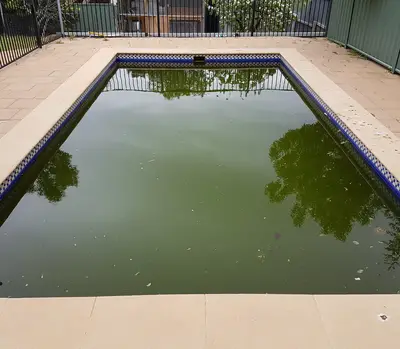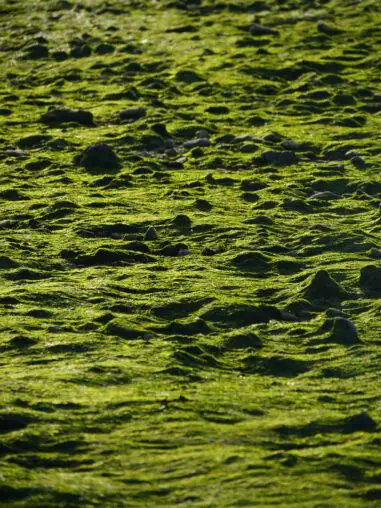
As the sun’s warmth beckons us to cool off in the pool during hot summer days, a lurking menace often threatens our aquatic bliss – algae. The sight of algae in a pool can be off-putting, leading to questions about the safety of taking a dip.
In this comprehensive guide, we will delve into the realm of algae-infested pools, exploring the potential health risks, debunking myths, and providing valuable insights into eradication and prevention.
Understanding Algae

Algae, those simple, plant-like organisms, can find their way into various environments, including swimming pools. Their diverse forms and colors can sometimes be confused with bacteria, making it essential to comprehend their types and causes.
Types of Pool Algae
Several types of algae can take root in your pool, each with unique characteristics:
- Green Algae: The most common type, typically treatable with proper maintenance.
- Black Algae: Known for its resilience, often found on plaster pool walls.
- Yellow Algae (Mustard Algae): Clings to shady pool areas and can be challenging to remove.
- Pink Algae: Actually bacteria resembling algae, requiring treatment for pool cleanliness.
Causes of Algae Growth
Algae’s growth in your pool can be attributed to several factors:
- Poor Circulation: Inadequate water circulation can create an environment where algae thrives.
- Unbalanced Water Chemistry: Maintaining the right chemical balance, including pH and alkalinity, is crucial to prevent algae growth.
- Warm, Stagnant Water: Algae love warm, still water, making proper circulation essential.
Health Risks of Swimming in Algae-Infested Pools
Swimming in a pool with algae isn’t just about battling the unsightly; it’s also a matter of health and safety. Algae-infested water can harbor harmful bacteria, primarily E. coli, leading to a range of health problems.
Bacterial Infection
Swimmers in algae-infested water risk exposure to harmful bacteria, resulting in symptoms such as stomach cramps, diarrhea, and fever. In severe cases, hospitalization may be required. Thus, clean, clear water signifies a safer swimming environment.
Skin Irritation
Algae can cause skin irritations, including itching, redness, and rashes, especially for individuals with sensitive skin or existing skin conditions. When the skin encounters algae, the body’s defensive reaction may lead to inflammation or irritation.
Respiratory Concerns
Certain types of algae, like blue-green algae or cyanobacteria, produce toxins that can be harmful when inhaled or ingested. Swimmers in algae-contaminated pools may inhale water droplets containing these toxins, resulting in respiratory problems such as throat irritation, coughing, and wheezing.
Eye Irritations
Algae-contaminated water can cause red, itchy, or stinging eyes. The discomfort may be immediate or develop hours after exposure due to imbalanced chemical levels present in algae-infested waters.
Slippery Surfaces
Algae’s slimy texture can make pool surfaces, such as the floor, steps, and ladders, treacherously slick. This increases the risk of swimmers slipping and falling, potentially resulting in minor bruises or more severe injuries like fractures.
Reduced Visibility
Proliferating algae can turn clear pool water into murky green, reducing visibility within the pool. This decreased visibility heightens the chances of accidents, collisions, or other safety hazards.
Gastrointestinal Issues
Swallowing even a small amount of algae-contaminated pool water can lead to stomach upset, with symptoms like nausea, vomiting, or diarrhea. To avoid such issues, pool water should remain clean and algae-free.
The Impact of Neglected Algae

Leaving algae untreated in your pool not only affects your health but also has repercussions on pool equipment, aesthetics, and structure.
Algae’s Effect on Pool Equipment
Neglected algae can clog pool filters, making them less efficient in maintaining pool cleanliness. This added strain can shorten the lifespan of pool pumps and circulation systems, leading to costly replacements or repairs.
Algae’s Effect on Pool Aesthetics and Structure
Neglected algae can stain or damage pool surfaces, equipment, and plumbing, resulting in expensive maintenance or replacement costs. The discoloration caused by algae can be stubborn and difficult to remove, leading to degradation over time.
Dealing with Algae: Eradication and Prevention
Taking immediate action upon discovering algae in your pool is crucial to ensure a safe swimming environment. Here are steps for eradication and preventive measures for the future:
Immediate Steps for Algae Removal
- Test and balance water chemistry, focusing on pH, chlorine, and algaecide levels.
- Activate the pump and filter system to circulate the water.
- Remove debris, such as leaves and dirt, from the pool.
- Brush pool walls and floor with a pool brush to dislodge algae.
- Vacuum the pool to remove dead algae and dirt.
- Shock the pool with a high dose of chlorine or a non-chlorine shock product to kill remaining algae spores.
- Run the filter for at least 24 hours to clear the water.
Preventative Measures for the Future
- Weekly testing and balancing of water chemistry, especially pH, chlorine, and algaecide levels.
- Weekly pool shocking with high-dose chlorine or a non-chlorine shock product.
- Consider using algaecide preventively to target algae growth.
- Weekly pool cleaning, including brushing, vacuuming, and skimming.
- Use a pool cover when the pool is not in use to reduce sunlight and debris.
- Run the circulation and filtration system for at least 8 hours daily for clear, sanitized water.
Seeking Professional Help
If algae issues persist despite your efforts, professional pool maintenance experts can identify and treat stubborn algae problems.
They can also provide tailored recommendations for maintaining proper water chemistry and sanitation practices for your specific pool type and environment.
Common Myths About Swimming in Algae-Infested Pools
In this section, we will debunk some common myths associated with swimming in pools with algae, providing clarity for a safer and healthier swimming experience.
Myth 1: A Little Algae Is Harmless
Even a small amount of algae in your pool can be harmful, potentially leading to severe health risks, skin irritation, eye infections, and respiratory issues. Do not underestimate the dangers of even minor algae growth.
Myth 2: Chlorine Alone Can Kill All Types of Algae
Chlorine may effectively eliminate some algae types, but others, like black and mustard algae, are more resistant and require additional treatments. Understand your pool’s algae types and use the appropriate methods for effective removal.
Myth 3: Algae Is Just a Visual Concern
Algae’s dangers extend beyond aesthetics. It can damage your pool’s function and maintenance by clogging filters, straining pumps, and harboring harmful bacteria and organisms. Neglecting algae can lead to costly repairs and jeopardize your health.
Conclusion
swimming in a pool with algae is not safe and poses various health risks. By understanding the types, causes, and consequences of algae growth, taking immediate action when algae appear, and adopting preventative measures, you can enjoy a clean and safe swimming environment.
Prioritizing pool maintenance and dispelling common myths about algae-infested pools will help ensure a healthier and more enjoyable swimming experience for all.









